Road Horses and Ponies: Saddle Horse Industry’s Answer to NASCAR
Wednesday, August 29, 2007
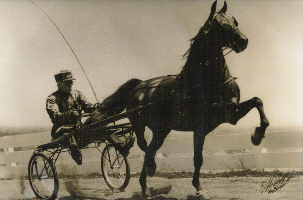
Lloyd Teater was the first trainer inducted
into the American Road Horse and Pony
Association Hall of Fame. His record of world’s
championship victories stood until 2006.
by Ann Bullard
Four-legged sports cars: that’s one way that road horse and pony enthusiasts look at the speedsters of the Saddle Horse world. Of course, these are not any sports cars. In terms of thrills and power, they rank up there with the Aston-Martin, the Ferrari … the choices of the dapper fictional hero, Hollywood or sports super-star.
Trainer Mike Felty describes the road horse as “the hot rod of our horse shows.” Ponies might be called sprint cars. Drivers in colorful silks, spinning bike or wagon wheels in the dirt as they cut a turn and dash down the straightaway, bring spectators to the edge of their seats – if not to their feet. Considered one of the most thrilling and challenging and thrilling divisions of the horse show, roadsters bring a bit of NASCAR’s element of danger to the show ring.
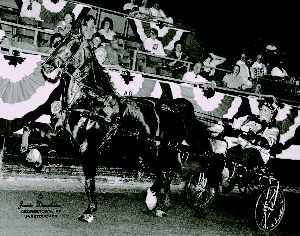
Jennie and Margaret Graham’s Nonstop had the reputation
of being the best to ever trot a turn. Trained early in her
career by the late Elton Cates and the late Don Roby, the
mare won her first world’s championship with the late
Dale Milligan in the bike. Raymond Shively took over
Nonstop’s career after Milligan’s death, winning the
world’s grand championship in 1982, ’83, ’84 and ’85.
In bygone days, horses that might work the fields during the week became the Sunday-go-to-meeting family transportation. ‘My horse is faster than yours’ became just as much a challenge to the driver as to one who might ride. Courthouse squares became the finish line for young sportsmen as they squared corners in their race into town. The advent of the automobile soon limited the competition to fairs, horse shows and racetracks.
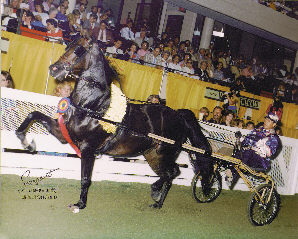
Shining Brightly set the standard in the ‘modern era,’
with the late Steve and later trainer Marilyn Macfarlane
in the bike. The nine-time world’s champion won the
amateur qualifier and grand championship every year
from 1985 through 1991. Marilyn Macfarlane drove him
to the open world’s grand championship, the first lady to
win this honor. Horse World readers voted Shining Brightly
the Roadster To Bike Horse of the Century as well as
of the decade 1990-2000.
The road horse has gone through many metamorphoses since those early days. Those appearing in the show ring today – with a few exceptions – are registered Standardbreds. The exceptions are ‘grandfathered in’ under the rules passed by the U.S. Trotting Association and United States Equestrian Federation. That was not without controversy.
Saying a roadster must trot, not pace, seems a simple requirement. Not so; ‘trotting stallions’ sired approximately 40% of the foals registered by the USTA in 2006.
Denny Lang, longtime pony trainer and manager of the Buffalo Raceway in New York, spoke of the difference in numbers – and some of the reasons behind them. “From the track standpoint, if we have one or two trotting races in a 13-card field, that’s a lot. It’s easier to produce a pacer than a trotter. A lot of the Standardbred racehorse people are taking the path of least resistance.”
Trainer Merrill Murray, who raced Standardbreds in Canada before becoming a Saddle Horse trainer, says that 95 percent of Standardbreds amble when they first go into training. “My dad used to tell me it took six months to make a pacer and two years to make a trotter. Years ago, there were a lot of cross-over horses that took the mark pacing and trotting. But when push comes to shove, they get in trouble at speed and revert back to their natural gait.”
Murray has been a proponent of showing only registered Standardbreds (rather than Saddlebred/Standardbred or other crosses) since the controversy’s onset. “We had been working in the Road Horse Association to get the [class] specifications organized and the judge to judge according to the specs [including doing three distinct gaits, a jog, road gait and at speed.] People said that we need to educate the judges. They are Saddle Horse people who love the high-headed horse.
“At first, people thought my objections were to half-breds winning,” Murray continued. “I am at the end of my career. I don’t want to look down [from above] at a high-headed horse that’s broke in two [out of time] and can’t trot. Are there pretty Standardbreds? Yes. Hard to find? Yes. I love that breed and think they should be their own entity.”
ARPHA Secretary Pat Cropper agrees. “Roadsters are not supposed to go with their heads tied back like a Saddlebred. It knocks their air off and they have to have air to get along,” she said.
When the ARPHA Board put the question of requiring road horses to be registered to the membership, Cropper reported that more than 80 percent voted for the proposal. Those already in the show ring – those ‘grandfathered in’ – may continue to show. That only applies to a handful of horses showing before Dec. 1, 2003.
Previously, rules called for a ‘Standardbred type’ horse, the “true” roadster according to trainer Kim Crumpler, an opponent of the new rule. “Recently, people had been going to a more Saddlebred-y looking head set and horses that didn’t move like a Standardbred. That sacrificed speed; that much I agree with.”
The horse the roadster exhibitor looks for isn’t necessarily the one best suited for the track. Art Zubrod has a foot in both worlds. He manages Brittany Farms, a Standardbred operation in Versailles, Ky. He and his wife Leah own Fair Island Farm, where they raise a limited number of Saddlebreds and Standardbreds. He also serves on the American Saddlebred Horse Association Board of Directors.
“We are breeding our horses to go as low and low-headed as possible,” Zubrod explained. “It’s not going to be too many years down the road that a Standardbred won’t hold its head up and put its knee high. In a few years, you won’t be able to find them.”
Debbie Foley is well known for her ability with a road horse. She has started five world’s champions: Private Party, All Glory, Dark Side, Bar None and Wuddacomover. Some came from the racetrack, perhaps through Chappy Chapman. Private Party, who dominated the bike division in the late 1990s, made the transition from pulling an Amish buggy to world’s champion bike horse.
“I look for a road horse that can put its head in the right place,” she said, acknowledging that many Standardbreds aren’t bred to be high-headed. “If they can’t get their heads up, they have a big problem right off the bat.”
Still she agrees with the rule change. “I do not think a road horse should have any Saddle Horse blood in them. A road horse is not a pleasure driving horse that trots faster. A Saddle Horse can’t trot fast enough to compete in a road horse class.
“Standardbred horses compete at one level of racing until they win so much money they have to step up. Some that step up can’t trot fast enough to win and there’s no place to race them. The Amish and others can buy them then; sometimes it’s a matter of waiting,” Foley said.
Foley weighed in on people’s attitude toward showing in the division. “It’s not something to take lightly,” she said. “I see a lot of amateur drivers who may not drive well enough to be doing that. They don’t realize driving a road horse is a whole different thing than showing a pleasure driving horse.
“I used to hate Louisville as it was the only place that had a ladies road horse class. We’d get there and see people who had never driven before and they show in that class. Most of these have been racehorses. When they get to a show, the racehorse comes out in them.”
So where do you find a good road horse prospect? There are almost as many answers to that question as there are types of horses. Few trainers have the time to go to – or even watch many Standardbred races. Amish people treasure a good buggy horse, often finding them at sales or off the track. David and Kore Yoder found horses for such people as the Freeman brothers, Danny Bugg and Debbie Foley.
“I still go to some of the Amish sales, such as Mt. Hope, Ohio and New Holland, Penn.,” David Yoder said. “A lot of people look there. That’s where I used to find most of them. Now I try to watch them on my computer when they’re on the track.
“If you find a nice prospect [at a sale,] you’ll have to give $10,000 or $15,000 for it. If it’s a good one, OK; but if it doesn’t pan out …,” Yoder continued, “Finding one that’s sound is the biggest problem when you find a trotter. There has to be some reason why they’re not racing any more.”
Virginian W.L. ‘Chappy’ Chapman finds and sells many of today’s road horses. “I started going to tracks and into the Amish country, where horses come in from Canada, several years ago. I met a lot of people and have spotters call me when they see one they think will make a show horse. Some make it, others don’t.”
Unlike some who spot and sell, Chapman works most of what he buys before calling those on his ‘buyers list.’ “I have to send a lot of horses back because of soundness problems,” he said, adding that occasionally he can heal them.
Learning to trot a tight show ring turn is the obvious challenge for horses used to dealing with long straight-aways and sweeping turns. Chapman says he spends a lot of time with them in the bullring. As most Standardbreds don’t have a long, archy neck, he teaches them to wear their heads.
How successful has he been? In recent years, World Grand Champion Big Red and world’s champions Cosmical, The Gingerbread Man and the under saddle champion Lady Hawke all came from Chapman. In 2002, Imagine That and Ruth Gimpel won the USTA Novice Roadster to Bike title at Louisville. He and the next three horses, Hilltop Hanover, Stop Watch and Wildwood Flower, passed through Chapman’s hands.
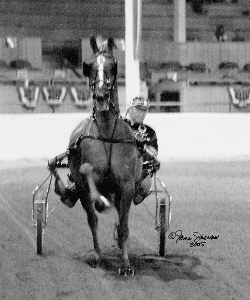
Big Red raced as Donvan Lincoln, winning a scant
$175 on the track. Chappy Chapman found him
at a Pennsylvania sale – and the rest is history.
Big Red has won much more than his track earnings
in prize money, plus countless ribbons and trophies
for DeLovely Farm and Raymond Shively. With his
stallion/gelding and grand championship wins at Louisville
2007, he brought Shively’s total bike victories to 18.
Those who show in these classes – from seasoned professionals to amateurs, ladies and youth revel in its thrills, whether in the bike, wagon or under saddle sections. Lindsey Greenwald, aboard High Velocity, Holly Ackerman with Vivacious and Rebekah Cloninger, with Diamond Hustler, all compete on the Carolina Circuit. Theirs is a ‘let the chips (or shavings) fall where they may relationship on the East Coast as well as in Kentucky. Their not sharing the top three spots is unusual.
Greenwald, a junior at Wake Forest University, shows High Velocity under Paul and Betsy Boone’s direction. Her other horses, most notably the three-gaited The Paper Boy ERB, are trained at her mother’s SGF Winning Ways Farm in Texas by Steve and May Chadick. She spoke of her initial response to the division and of the contrasts between her wide-open roadster and highly cadenced three-gaited star.
“When I was in academy, we went to Oklahoma City where I watched an under saddle road horse class with two horses. I remember the announcer saying the exact same prayers from those two people … ‘Thanks for getting me through this class’ and ‘I’ll never do it again.’ I remember thinking it looked too scary. I never was going to do that.”
Four years ago, Frankel paired her daughter with the proven High Velocity. She initially showed him to bike. At the American Royal, she stepped into the irons and tied second. She has enjoyed riding him ever since.
She describes her two horses as “one hold ’em and one push. When I come home from the Carolinas, May [Chadick] spends so much time with me on lesson horses before I get on Paper Boy. It’s the same when I go back to the Carolinas. This makes a rider so versatile.”
Vivacious was well established as bike horse for the Beltle family when Dr. Holli Ackerman purchased her. The black mare’s record includes the 2000 Roadster to Bike Mares World Championship with trainer Mike Felty and numerous championships with Ross Beltle in the bike.
“The man who bought Cleveland Park (from the Greenwell family) bought her. I rode her and had to have her,” Ackerman said, explaining she still shows under Mark and Mary Lou Greenwell’s direction. “Last year I showed her to the bike at Lexington and won. I haven’t driven her since.”
At 30-years of age, the pharmacist elects to remain in the saddle rather than the bike. For her, it’s safety first.
“It’s easier to predict which way a horse is going when you’re riding rather than driving,” she said. “The main deal is to go deep into turns to prevent falls. Everyone gets excited, but we don’t race side by side. It’s all about excitement, power that you have to keep contained.”
Vivacious is one of the roadsters grandfathered in under the new rules. As a half Saddlebred, she can show, but cannot produce foals for the show ring.
What does it take to show a roadster under saddle? Ackerman termed it “competitive fire and guts. It can get a little wild out there. You have to be intelligent and aware of your surroundings at all times.”
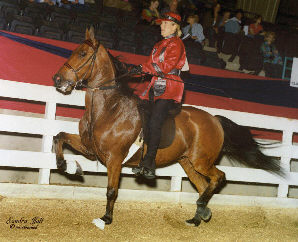
Professionals and amateurs thrill the crowds
when riding roadsters rather than driving them.
Melinda Moore, pictured aboard PTO, has won
numerous world’s championships in this division.
The youngest of the three leading contenders for amateur under saddle honors, Rebekah Cloninger and Diamond Hustler have been partners for three years, showing in youth bike as well as youth and amateur under saddle competition. Riding under Lewis Eckard and Gina Lail’s direction at Drowning Creek Farm, Cloninger’s ‘other horse,’ CH Dusty Beau, stays near the top in the junior exhibitor five-gaited division.
She has experienced the scare from a horse’s fall in the ring. “Three years ago at Blue Ridge, my horse and I fell down. I got right back up and kept going,” she recalled. “I’ve been very lucky and have done very well.”
Diamond Hustler continues to excel, despite his being 21 years of age. At Louisville 2006, the Cloningers purchased Royal Count, a horse she has shown successfully to bike as well as under saddle classes.
These three young ladies seem quite sane compared with some of those who have and still show bike and wagon horses. The late Dewey Henderson was one who put the term showman into the road horse division. Not only was he an excellent and successful driver, his trademark standing in the bike as he did with Diablo at Lexington Junior League remains part of road horse lore.
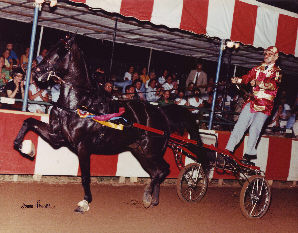
Before his death, Dewey Henderson could truly be
termed one of the industry’s ‘characters.’ Driving
in the days when riders sometimes engaged in whip
fights and other antics, Henderson’s standing
in the road bike as he raced down a straightaway
remains firmly fixed in long-time fans’ memories.
Henderson’s good friend, the late Ray Pittman, carried that ‘character’ banner until his death. He has many claims to road horse and pony fame. The two most notable: the road horse TNT and the many-times world’s champion road pony I’ve Arrived.
John Crawford of Wartrace, Tenn., could have been termed the king of road horses from the early 1950s until he closed his business in the 1980s. Calling him a colorful character doesn’t do Crawford justice. His love for speed showed even in childhood when he received a speeding ticket – while on his horse. He learned about shoeing trotters from his father.
Those who knew Crawford best described him as “an experienced horseman, highly-skilled salesman, gambler, ladies man, comedian, businessman, fisherman and all-around colorful character.” He labeled his most-respected friends with the title “Governor.” They, in turn, bestowed the same honor on him. Crawford not only trained and sold thousands of Saddlebreds and roadsters, he mentored many of the business’s top trainers including Raymond Shively. Crawford’s partner, John Cooper, encouraged Lillian Shively to begin her teaching career.
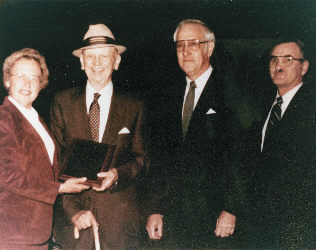
John Crawford started many horses – and trainers -
between the 1950s until his death in the mid 1980s.
One of his most famous combinations: Amateur World’s
Grand Champion Eyre Lad, shown by both Winston Garth
and John Cooper. He is pictured at his
Hall of Fame induction in 1984.
Crawford trained the great Eyre Lad for Winston Garth and later for Cooper. Garth and the stallion were the first to win three-consecutive Amateur Roadster to Bike World’s Championships. Other champions that passed through Crawford’s hands include Miss Eyre, the wagon mare Our Honey, Royal Ace, Wild Cedar and Moonshot.
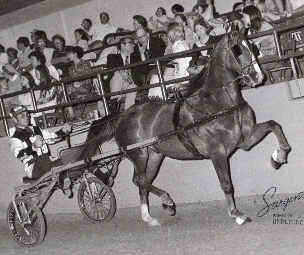
Wild Cedar campaigned successfully on the Southwest
circuit and national level in the 1980s. The late Don Roby
shared the lines with ‘Chink’ Ogden, son of the late
Mary Anne Ogden of New Orleans.
Milward Dedman of Harrodsburg, Ky., is the third generation of his family involved with roadsters. His grandfather, Edwin Freeman, and great uncles, Marshall and R.C., showed under the Freeman Brothers banner. Edwin Freeman, the best-known of the three, showed such world’s champion bike and wagon horses as Miss Dean Key, Air Express, The Invader, Shane, The Auctioneer and Captain Gene.
Not only did the Freemans have great horses, they brought one of the industry’s biggest characters and most-loved trainers, the late Willie ‘Jack Rabbit’ Bottoms onto the show horse scene.
“Rabbit just loved a horse. He often said he loved them as much as he did a human; he spent most of his life with them,” Dedman said nostalgically. “He lived at the barn at the [Harrodsburg] fairgrounds. He always told me he was the fourth Freeman brother.”
Bottoms also brought along two young men who followed him into road horse history. Dedman shows BJ’s Hail Storm; his good friend and competitor, Danny Bugg, carries on both the winning tradition and that of being what might conservatively being called a colorful figure. His red, white and blue silks stand out among the more traditional ones worn by fellow competitors in bike classes. In wagon competition, he is properly attired in a duster and hat and goes all out to earn the blue.
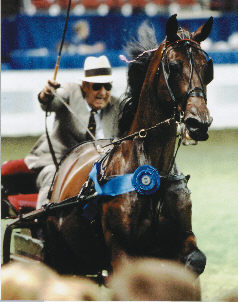
The late Pres Oder’s career spanned many decades
and many outstanding horses. He, Raymond Shively,
‘Jack Rabbit’ Bottoms and others’ duels in road wagon
classes remain part of roadster history. Glenmore Farm’s
Catch Me was one of the greatest.
Roadster ponies began to hit the peak in popularity during the 1960s. Their ambition, drive and way of going set them apart from other registered Hackney ponies. With the drivers or riders clad in colorful silks, this division, one of the most competitive at the horse show, remains a crowd favorite. Like the road horses, they show to the bike and with junior exhibitors in under saddle classes. In 2006 they added a roadster pony to wagon division.

The newest roadster pony division features
ponies to wagon. Razz-Ma-Tazz and Lewis
Eckard won the inaugural world’s champion-
ship in 2006 for owner Karl Bridgeman.
Trainer Mike Felty clarified what others voiced. “If someone wants to show and is not a rider, a road pony is a good way to start. The element of danger is a lot less than with a road horse. After they’ve done that a while, they can graduate to a little faster sports car.”
“A road pony usually is busier-motioned than a harness, cobtail or pleasure pony,” Dr. Alan R. Raun of Reedannland explained. “He takes more steps to the minute to cover the same distance.”
Roadster ponies show at the jog and road gait both ways of the ring, adding speed as the final gear on the reverse. Years ago, Raun said speed was 50 percent of the scoring. He doesn’t think they are judged that way today.
“All ponies in the show ring have to use their ears, be attractive and have a certain amount of pizzazz,” Raun continued. “Roadsters drive off their hocks; that’s where they get their speed.
“Slow-motion ponies do not make good road ponies,” he added. “If he hangs up or dwells with his hock action or has hesitation at the top of the arc of the flight of his foot, that will prevent his going at any speed.”
Mary and Jeff McClean and trainer Tom Lowry keep Golden Creek Farms at the top of the Hackney Pony contenders. Jeff McClean says his wife’s forte “is long-tails. We shoot for that. We have all three [types;] we fit the glove to the pony.”
Prince’s Performer, the pony Jeff drove to blues in the UPHA Roadster Pony Classics at Midwest and Lexington Junior League, is one of the few they bought to be a road pony. “He is so long-necked. We knew he couldn’t be a cobtail because of his hocks. He’s so powerful and long-necked. He’s just gorgeous.”
McClean pointed out that it’s possible to manufacture a little motion if it’s needed. Ears, neck and quality are bred into them.
“I always try to buy one that runs off,” he said with a smile in his voice. “We want all that get up and go. We’ll eventually get them broke.”
McClean looked at the great ponies of bygone days. “Mary had some great ones with John [Shea.]”
Those ‘great ones’ included Perfect Impression, driven by Gaylord to the 1983 and ’84 Roadster Pony World’s Grand Championship. She teamed Shamask to the amateur championship in 1990 and ’91. Shea directed Gaylord and the popular Bill Bailey to numerous wins from the southeast to Kentucky and beyond.
McClean continued discussing other top ponies. “Hazard County was one of the best for many owners. I’ve Arrived, winner of 13 world’s championships, was one of, if not the greatest of all time.”
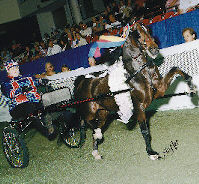 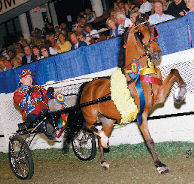
I’ve Arrived and Free Willy arguably are the two
best roadster ponies in history. I’ve Arrived, introduced
to show ring fame by the late Ray Pitman, dominated
the division, winning 15 world’s championships. He is
pictured (left) with Anna Johnson of Chanticleer Farm
in the bike. Free Willy came on the scene at the end
of I’ve Arrived’s career. The eight time world’s
champion and current world’s grand champion is
shown (right) with Georgia Blevins on the lines.
Jerry Blevins and his family own Free Willy, Lamborghini, Heartland Sundust and Dun-Haven Grandiose. He spoke of the changes since he, his wife, Georgia, and daughter, Mia, entered the business. “When we first started, there would be two different types of ponies that gave judges fits. One could go like a road horse but not as high or with as much style. He would stay on the rail. The other, a pretty pony, set-up good and could go high but not as fast. Drivers would keep them around the judge’s stand. We learned pretty soon that we could do OK with those at small shows, but when we got to the big ones, the pony either must do both or judges would tie ones that could move on pretty good.”
“We happened to come along when road ponies were changing. They had to go fast and still have style. Today’s ponies set up, have a hook in their necks, go high and have the extra gear and desire to go on. When I look back to yesterday, they are very, very different.”
Gib Marcucci specializes in ponies, training some of the best of all time for the late Sallie Wheeler as well as his current group of clients. He considers Hazard County, winner of four consecutive world’s championships for drivers 14-17 years of age with Glenn T. Werry on the lines, one of the best ever. Marcucci says a pony’s being successful as a long-tail and roadster pony is rare.
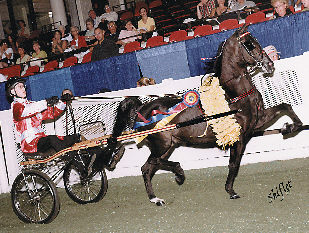
Many trainers put Hazard County in the elite group.
The pony, whose life and career were cut short
due to an injury, won world’s titles for Rick
Wallen, Melody Adler, the late Ed Frickey
and Glenn T. Werry.
Golden Creek Farms’ Heartland Production is one of those who made a successful switch between harness and pleasure driving to roadster pony. Mary and Jeff McClean share the drives on this world’s champion pony. They head into Louisville with blues and tricolors from Lexington and Midwest in their 2007 record.
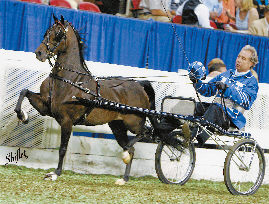
Jeff and Mary Gaylord McClean of Golden
Creek Farms have starred in the pony division
for decades. She first had champion ponies
with John Shea. Today, Tom Lowry trains the
family’s champions. Two of the farm’s world’s
champions, Beaulah Jean and Heartland Production,
are shown with Jeff and Mary McClean
respectively in the bike.
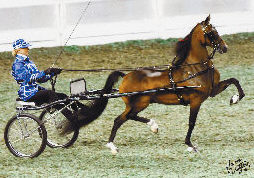
“He’s just shod differently,” Marcucci said. “If you put a round bridle on him, he probably could show as a harness pony again.”
Marcucci spoke of changes in the way judges look at roadster ponies today. “We’ve gotten away from the quick-footed pony that we had when we wanted them to look like a road horse,” Marcucci said. “Now many look like harness ponies again. We ask them to turn on and most can’t go on that fast any more. We might as well ask for two gaits. The long neck is great but they ought to be able to trot on and can’t. Saddle Horse boys look at those and tie them.”
Rick Wallen has trained successful road ponies for years as well as being a sought-after judge. He wants “one that goes out there and gives me three separate, distinct gaits. We get so many classes where ponies come in road-gaiting and have nothing left for speed because drivers have used the pony up the first way.”
Wallen says he loves a pretty pony. “The seven or eight we’re showing this year all are beautiful, handsome – or good looking. I don’t care if one stands in the stall and hangs its head. It can look like a ‘plain Jane’ in the stall. If it swells up, comes to life and has stamina in the stall, that’s what I want.”
Mike and Jane Schallock’s Nightheir showed as a harness as well as a road pony early in its career. He is one of the world’s or reserve world’s champions Wallen will have at Freedom Hall.
Rich Campbell is never one to step back from controversy. “Ponies have definitely changed from the years of just wanting speed and action to also wanting head set and carriage. A long time ago, everyone wanted to win the race at the end of the class. The pony who would zip around and blow the doors off would be the winner.
“There are two jogs, two road gaits and one ‘at speed’ [in the specifications.] If a pony steps up, he doesn’t have to be the fastest to win the class. Now we want a pony that is more brilliant – a show animal.”
Several years ago, an Alabama barn’s advertising tagline read, “I feel the need … the need for speed.” They aren’t the only ones.
|